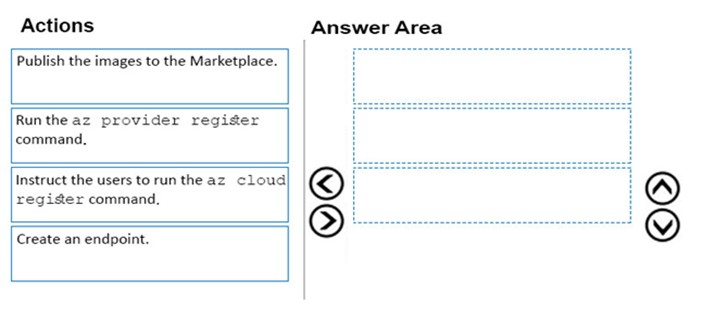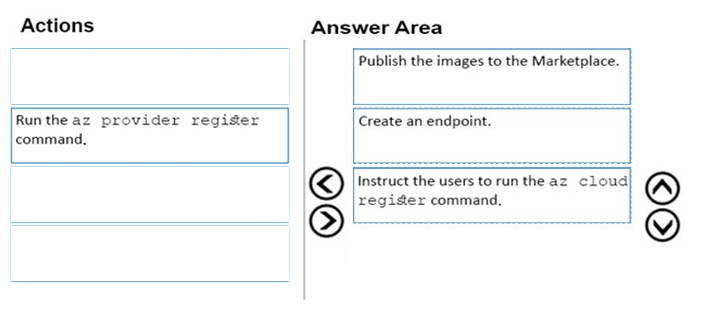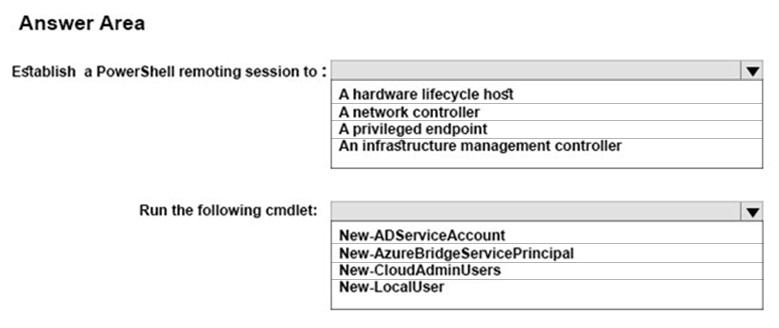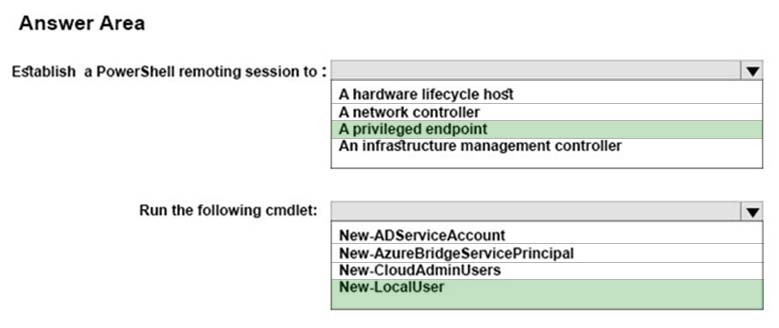Microsoft 70-537 Exam Practice Questions (P. 5)
- Full Access (67 questions)
- Six months of Premium Access
- Access to one million comments
- Seamless ChatGPT Integration
- Ability to download PDF files
- Anki Flashcard files for revision
- No Captcha & No AdSense
- Advanced Exam Configuration
Question #21
DRAG DROP -
You have an Azure Stack integrated system.
Several users use the Microsoft Azure CLI to manage Azure Stack resources.
You need to ensure that the users can use Azure CLI to deploy virtual machines by using templates from the Marketplace. The solution must ensure that the users can reference images by using aliases.
Which three actions should you perform in sequence? To answer, move the appropriate actions from the list of actions to the answer area and arrange them in the correct order.
Select and Place:

You have an Azure Stack integrated system.
Several users use the Microsoft Azure CLI to manage Azure Stack resources.
You need to ensure that the users can use Azure CLI to deploy virtual machines by using templates from the Marketplace. The solution must ensure that the users can reference images by using aliases.
Which three actions should you perform in sequence? To answer, move the appropriate actions from the list of actions to the answer area and arrange them in the correct order.
Select and Place:

Correct Answer:

References:
https://docs.microsoft.com/fi-fi/azure///azure-stack/user/azure-stack-version-profiles-azurecli2#get-the-virtual-machine-aliases-endpoint

References:
https://docs.microsoft.com/fi-fi/azure///azure-stack/user/azure-stack-version-profiles-azurecli2#get-the-virtual-machine-aliases-endpoint
send
light_mode
delete
Question #22
Note: This question is part of a series of questions that use the same scenario. For your convenience, the scenario is repeated in each question. Each question presents a different goal and answer choices, but the text of the scenario is exactly the same in each question in this series.
Start of repeated scenario.
Your company has a main office in New York and a branch office in Toronto. Each office has a dedicated connection to the Internet. Each office has a firewall that uses inbound and outbound rules.
The company has an on-premises network that contains several datacenters. The datacenters contain multiple hypervisor deployments, including Window Server
2016 Hyper-V. The network uses Microsoft System Center for monitoring and Windows Azure Pack for self-service.
The company has a Microsoft Azure subscription that contains several workloads. You use Azure Resource Manager templates and other automated processes to create and manage the resources in Azure.
You have an Azure Stack integrated system in the New York office. The company has a deployment team in the Toronto office and a development team in the
New York office. The system has an offer named Offer1. Several tenants have subscriptions based on Offer1.
You have a Hyper-V host named Server1 that runs Windows Server 2012 R2. Server1 is used for testing. The hardware on Server1 can support the deployment of the Azure Stack Development Kit.
You have a Generation 1 virtual machine named VM1 that runs Windows Server 2012 R2. VM1 is deployed to a Hyper-V host that runs Windows Server 2016.
VM1 has a fixed size disk named VM1.vhdx that is 200 GB.
End of repeated scenario.
The development team in the Toronto office fails to access the Azure Stack integrated system. The team successfully accesses the Azure subscriptions. The development team in the New York office successfully accesses the Azure Stack integrated system.
You need to ensure that the Toronto development team can access the system.
What should you do?
Start of repeated scenario.
Your company has a main office in New York and a branch office in Toronto. Each office has a dedicated connection to the Internet. Each office has a firewall that uses inbound and outbound rules.
The company has an on-premises network that contains several datacenters. The datacenters contain multiple hypervisor deployments, including Window Server
2016 Hyper-V. The network uses Microsoft System Center for monitoring and Windows Azure Pack for self-service.
The company has a Microsoft Azure subscription that contains several workloads. You use Azure Resource Manager templates and other automated processes to create and manage the resources in Azure.
You have an Azure Stack integrated system in the New York office. The company has a deployment team in the Toronto office and a development team in the
New York office. The system has an offer named Offer1. Several tenants have subscriptions based on Offer1.
You have a Hyper-V host named Server1 that runs Windows Server 2012 R2. Server1 is used for testing. The hardware on Server1 can support the deployment of the Azure Stack Development Kit.
You have a Generation 1 virtual machine named VM1 that runs Windows Server 2012 R2. VM1 is deployed to a Hyper-V host that runs Windows Server 2016.
VM1 has a fixed size disk named VM1.vhdx that is 200 GB.
End of repeated scenario.
The development team in the Toronto office fails to access the Azure Stack integrated system. The team successfully accesses the Azure subscriptions. The development team in the New York office successfully accesses the Azure Stack integrated system.
You need to ensure that the Toronto development team can access the system.
What should you do?
- AFor the Toronto development team, allow the inbound endpoints of the Azure Stack infrastructure on the New York office firewalls.
- BCreate a site-to-site VPN connection from Azure to the New York office.
- CFor the Toronto development team, allow ports 4443 and 8080 on the New York firewalls.
- DConfigure and enable iDNS.
Correct Answer:
B
References:
https://docs.microsoft.com/en-us/azure/azure-stack/azure-stack-connect-vpn https://docs.microsoft.com/en-us/azure/azure-stack/user/azure-stack-solution-hybrid-connectivity
B
References:
https://docs.microsoft.com/en-us/azure/azure-stack/azure-stack-connect-vpn https://docs.microsoft.com/en-us/azure/azure-stack/user/azure-stack-solution-hybrid-connectivity
send
light_mode
delete
Question #23
Note: This question is part of a series of questions that use the same scenario. For your convenience, the scenario is repeated in each question. Each question presents a different goal and answer choices, but the text of the scenario is exactly the same in each question in this series.
Start of repeated scenario.
Your company has a main office in New York and a branch office in Toronto. Each office has a dedicated connection to the Internet. Each office has a firewall that uses inbound and outbound rules.
The company has an on-premises network that contains several datacenters. The datacenters contain multiple hypervisor deployments, including Window Server
2016 Hyper-V. The network uses Microsoft System Center for monitoring and Windows Azure Pack for self-service.
The company has a Microsoft Azure subscription that contains several workloads. You use Azure Resource Manager templates and other automated processes to create and manage the resources in Azure.
You have an Azure Stack integrated system in the New York office. The company has a deployment team in the Toronto office and a development team in the
New York office. The system has an offer named Offer1. Several tenants have subscriptions based on Offer1.
You have a Hyper-V host named Server1 that runs Windows Server 2012 R2. Server1 is used for testing. The hardware on Server1 can support the deployment of the Azure Stack Development Kit.
You have a Generation 1 virtual machine named VM1 that runs Windows Server 2012 R2. VM1 is deployed to a Hyper-V host that runs Windows Server 2016.
VM1 has a fixed size disk named VM1.vhdx that is 200 GB.
End of repeated scenario.
You need to ensure that you can import VM1 to Azure Stack.
What should you do?
Start of repeated scenario.
Your company has a main office in New York and a branch office in Toronto. Each office has a dedicated connection to the Internet. Each office has a firewall that uses inbound and outbound rules.
The company has an on-premises network that contains several datacenters. The datacenters contain multiple hypervisor deployments, including Window Server
2016 Hyper-V. The network uses Microsoft System Center for monitoring and Windows Azure Pack for self-service.
The company has a Microsoft Azure subscription that contains several workloads. You use Azure Resource Manager templates and other automated processes to create and manage the resources in Azure.
You have an Azure Stack integrated system in the New York office. The company has a deployment team in the Toronto office and a development team in the
New York office. The system has an offer named Offer1. Several tenants have subscriptions based on Offer1.
You have a Hyper-V host named Server1 that runs Windows Server 2012 R2. Server1 is used for testing. The hardware on Server1 can support the deployment of the Azure Stack Development Kit.
You have a Generation 1 virtual machine named VM1 that runs Windows Server 2012 R2. VM1 is deployed to a Hyper-V host that runs Windows Server 2016.
VM1 has a fixed size disk named VM1.vhdx that is 200 GB.
End of repeated scenario.
You need to ensure that you can import VM1 to Azure Stack.
What should you do?
- ARecreate VM1 as a Generation 2 virtual machine.
- BConvert the disk to a VHD.
- CConvert the disk to a dynamically expanding disk.
- DUpgrade VM1 to Windows Server 2016.
Correct Answer:
B
Azure supports only generation 1 VMs that are in the VHD file format and have a fixed sized disk. The maximum size allowed for the VHD is 1,023 GB. You can convert a generation 1 VM from the VHDX file system to VHD and from a dynamically expanding disk to fixed-sized. But you can't change a VM's generation.
Incorrect Answers:
A: Azure supports only generation 1 VMs that are in the VHD file format.
C: Azure Stack does not support dynamic VHDs. Resizing a virtual machine (VM) with a dynamic disk attached to it leaves the VM in a failed state.
References:
https://docs.microsoft.com/en-za/azure/virtual-machines/windows/prepare-for-upload-vhd-image https://docs.microsoft.com/en-us/azure/azure-stack/azure-stack-update-1802
B
Azure supports only generation 1 VMs that are in the VHD file format and have a fixed sized disk. The maximum size allowed for the VHD is 1,023 GB. You can convert a generation 1 VM from the VHDX file system to VHD and from a dynamically expanding disk to fixed-sized. But you can't change a VM's generation.
Incorrect Answers:
A: Azure supports only generation 1 VMs that are in the VHD file format.
C: Azure Stack does not support dynamic VHDs. Resizing a virtual machine (VM) with a dynamic disk attached to it leaves the VM in a failed state.
References:
https://docs.microsoft.com/en-za/azure/virtual-machines/windows/prepare-for-upload-vhd-image https://docs.microsoft.com/en-us/azure/azure-stack/azure-stack-update-1802
send
light_mode
delete
Question #24
Note: This question is part of a series of questions that use the same scenario. For your convenience, the scenario is repeated in each question. Each question presents a different goal and answer choices, but the text of the scenario is exactly the same in each question in this series.
Start of repeated scenario.
Your company has a main office in New York and a branch office in Toronto. Each office has a dedicated connection to the Internet. Each office has a firewall that uses inbound and outbound rules.
The company has an on-premises network that contains several datacenters. The datacenters contain multiple hypervisor deployments, including Window Server
2016 Hyper-V. The network uses Microsoft System Center for monitoring and Windows Azure Pack for self-service.
The company has a Microsoft Azure subscription that contains several workloads. You use Azure Resource Manager templates and other automated processes to create and manage the resources in Azure.
You have an Azure Stack integrated system in the New York office. The company has a deployment team in the Toronto office and a development team in the
New York office. The system has an offer named Offer1. Several tenants have subscriptions based on Offer1.
You have a Hyper-V host named Server1 that runs Windows Server 2012 R2. Server1 is used for testing. The hardware on Server1 can support the deployment of the Azure Stack Development Kit.
You have a Generation 1 virtual machine named VM1 that runs Windows Server 2012 R2. VM1 is deployed to a Hyper-V host that runs Windows Server 2016.
VM1 has a fixed size disk named VM1.vhdx that is 200 GB.
End of repeated scenario.
You implement a SQL Server resource provider that uses D14v2 virtual machines.
A tenant creates a SQL database that runs several heavy workloads. The tenant reports that SQL queries are slow to complete.
You need to recommend changes to the Azure Stack integrated system to reduce the amount of time required to complete the SQL queries.
What should you recommend?
Start of repeated scenario.
Your company has a main office in New York and a branch office in Toronto. Each office has a dedicated connection to the Internet. Each office has a firewall that uses inbound and outbound rules.
The company has an on-premises network that contains several datacenters. The datacenters contain multiple hypervisor deployments, including Window Server
2016 Hyper-V. The network uses Microsoft System Center for monitoring and Windows Azure Pack for self-service.
The company has a Microsoft Azure subscription that contains several workloads. You use Azure Resource Manager templates and other automated processes to create and manage the resources in Azure.
You have an Azure Stack integrated system in the New York office. The company has a deployment team in the Toronto office and a development team in the
New York office. The system has an offer named Offer1. Several tenants have subscriptions based on Offer1.
You have a Hyper-V host named Server1 that runs Windows Server 2012 R2. Server1 is used for testing. The hardware on Server1 can support the deployment of the Azure Stack Development Kit.
You have a Generation 1 virtual machine named VM1 that runs Windows Server 2012 R2. VM1 is deployed to a Hyper-V host that runs Windows Server 2016.
VM1 has a fixed size disk named VM1.vhdx that is 200 GB.
End of repeated scenario.
You implement a SQL Server resource provider that uses D14v2 virtual machines.
A tenant creates a SQL database that runs several heavy workloads. The tenant reports that SQL queries are slow to complete.
You need to recommend changes to the Azure Stack integrated system to reduce the amount of time required to complete the SQL queries.
What should you recommend?
- AResize the virtual machine that provides the Microsoft SQL Server service.
- BInstruct the tenant to install Microsoft SQL Server on a virtual machine in its subscription.
- CIn the Azure Stack integrated system, cluster the D14v2 virtual machines.
- DDeploy a physical server that has more resources that the D14v2 virtual machines. Install Microsoft SQL Server on the server. Add the server to the SQL Server resource provider.
Correct Answer:
D
D
send
light_mode
delete
Question #25
HOTSPOT -
Note: This question is part of a series of questions that use the same scenario. For your convenience, the scenario is repeated in each question. Each question presents a different goal and answer choices, but the text of the scenario is exactly the same in each question in this series.
Start of repeated scenario.
Your company has a main office in New York and a branch office in Toronto. Each office has a dedicated connection to the Internet. Each office has a firewall that uses inbound and outbound rules.
The company has an on-premises network that contains several datacenters. The datacenters contain multiple hypervisor deployments, including Window Server
2016 Hyper-V. The network uses Microsoft System Center for monitoring and Windows Azure Pack for self-service.
The company has a Microsoft Azure subscription that contains several workloads. You use Azure Resource Manager templates and other automated processes to create and manage the resources in Azure.
You have an Azure Stack integrated system in the New York office. The company has a deployment team in the Toronto office and a development team in the
New York office. The system has an offer named Offer1. Several tenants have subscriptions based on Offer1.
You have a Hyper-V host named Server1 that runs Windows Server 2012 R2. Server1 is used for testing. The hardware on Server1 can support the deployment of the Azure Stack Development Kit.
You have a Generation 1 virtual machine named VM1 that runs Windows Server 2012 R2. VM1 is deployed to a Hyper-V host that runs Windows Server 2016.
VM1 has a fixed size disk named VM1.vhdx that is 200 GB.
End of repeated scenario.
You need to provide a new user with the ability to generate support session tokens when troubleshooting Azure Stack issues with Microsoft Support.
What should you do? To answer, select the appropriate options in the answer area.
NOTE: Each correct selection is worth one point.
Hot Area:

Note: This question is part of a series of questions that use the same scenario. For your convenience, the scenario is repeated in each question. Each question presents a different goal and answer choices, but the text of the scenario is exactly the same in each question in this series.
Start of repeated scenario.
Your company has a main office in New York and a branch office in Toronto. Each office has a dedicated connection to the Internet. Each office has a firewall that uses inbound and outbound rules.
The company has an on-premises network that contains several datacenters. The datacenters contain multiple hypervisor deployments, including Window Server
2016 Hyper-V. The network uses Microsoft System Center for monitoring and Windows Azure Pack for self-service.
The company has a Microsoft Azure subscription that contains several workloads. You use Azure Resource Manager templates and other automated processes to create and manage the resources in Azure.
You have an Azure Stack integrated system in the New York office. The company has a deployment team in the Toronto office and a development team in the
New York office. The system has an offer named Offer1. Several tenants have subscriptions based on Offer1.
You have a Hyper-V host named Server1 that runs Windows Server 2012 R2. Server1 is used for testing. The hardware on Server1 can support the deployment of the Azure Stack Development Kit.
You have a Generation 1 virtual machine named VM1 that runs Windows Server 2012 R2. VM1 is deployed to a Hyper-V host that runs Windows Server 2016.
VM1 has a fixed size disk named VM1.vhdx that is 200 GB.
End of repeated scenario.
You need to provide a new user with the ability to generate support session tokens when troubleshooting Azure Stack issues with Microsoft Support.
What should you do? To answer, select the appropriate options in the answer area.
NOTE: Each correct selection is worth one point.
Hot Area:

Correct Answer:

References: https://docs.microsoft.com/en-us/azure/azure-stack/azure-stack-privileged-endpoint

References: https://docs.microsoft.com/en-us/azure/azure-stack/azure-stack-privileged-endpoint
send
light_mode
delete
All Pages
